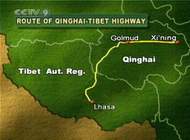|
Qinghai-Tibet highway witnesses changes 
|
| 2002-10-14 09:26:12 |
As part of the Western Development strategy, the Chinese government is increasing its investment in the country's western regions, especially in infrastructure. This year, the government decided to upgrade the Qinghai-Tibet highway, which is an important gateway to Tibet. The Qinghai-Tibet highway bears witness to the changes in the region.
 The Qinghai-Tibet highway, the road to the roof of the world, is the life line of Tibet. Crossing the vast Gobi desert and some of the world's highest mountain terrain, the highway was once the most hazardous road on earth.
The Qinghai-Tibet highway, the road to the roof of the world, is the life line of Tibet. Crossing the vast Gobi desert and some of the world's highest mountain terrain, the highway was once the most hazardous road on earth.
Trucks carrying all kinds of goods travel this road all year round. Driving on the road is a daunting task and a difficult experience despite some incredibly spectacular scenery along the way. There are many stories of breakdowns, landslides, and long traffic jams.
Forty-year-old Zhu Yongliang has used this road for nearly 10 years. Throughout all those years, he gained a deeper understanding of how difficult driving can be. The road conditions used to be terrible and breakdowns were common, said Zhu, who also recalled traffic jams that kept him waiting for as long as several days.
First built in the late 1950s, the Qinghai-Tibet highway links Xining, the capital of Qinghai Province, and Lhasa, the capital of the Tibet Autonomous Region, spanning a handsome 1,160 kilometers. The road has been kept open since in spite of the harsh conditions because it's extremely important for the local economy.
 Wang Tingdong, deputy head of the Qinghai Province Transportation Department, said, "The Qinghai-Tibet highway is the most important passage leading to Tibet. About 80-90 percent of all the goods to Tibet are transported along this road."
Wang Tingdong, deputy head of the Qinghai Province Transportation Department, said, "The Qinghai-Tibet highway is the most important passage leading to Tibet. About 80-90 percent of all the goods to Tibet are transported along this road."
"Opened nearly 50 years ago, the Qinghai-Tibet highway has played an irreplaceable role in the local economy and in people's livelihood. It also bears witness to the changes of the last half century."
Changes? Yes, many. When it was first built, the highway was more or less a dirt road like this. After years of renovation and construction, the whole length of the highway became a tarmac road in 1985. This year, the government decided to invest about 1.2 billion yuan to upgrade the road. Soon, this is what the whole road will look like. The transportation capacity will be increased 2.8 times.
The road is getting better, and so are services along the highway, with gas stations, restaurants and hotels mushrooming.
 This bus company used to be the only one serving the Qinghai-Tibet road with only about 100 to 200 passengers a day. Now dozens of bus companies are running on the line. The number of passengers are increasing, and Yang Haining, deputy manager of the Bus Company, Qinghai Transportation Group, said, "Before the reform and opening up, most passengers were pilgrims and people who lived in Tibet. Now, there are tourists, businessmen, all kinds of people."
This bus company used to be the only one serving the Qinghai-Tibet road with only about 100 to 200 passengers a day. Now dozens of bus companies are running on the line. The number of passengers are increasing, and Yang Haining, deputy manager of the Bus Company, Qinghai Transportation Group, said, "Before the reform and opening up, most passengers were pilgrims and people who lived in Tibet. Now, there are tourists, businessmen, all kinds of people."
Half-way between Qinghai and Tibet, you will come across this town, Gormut. Starting from a transfer station in the 1950s when the Qinghai-Tibet highway was first built, the town literally grew from scratch in the desert. Today, it is a bustling city with a population of 200,000 and a pearl in the wild Qaidam Basin. The future of the city and the entire region looks more promising with the upgrading of the road.
The locals call the highway "Road to Heaven" because of its high altitude which averages 4,000 meters above sea level. Only the drivers themselves know how difficult it used to be to get to heaven. But, when the current upgrading of the road is completed next year, the highway may live up to its name and become a real heavenly road.
|
|










